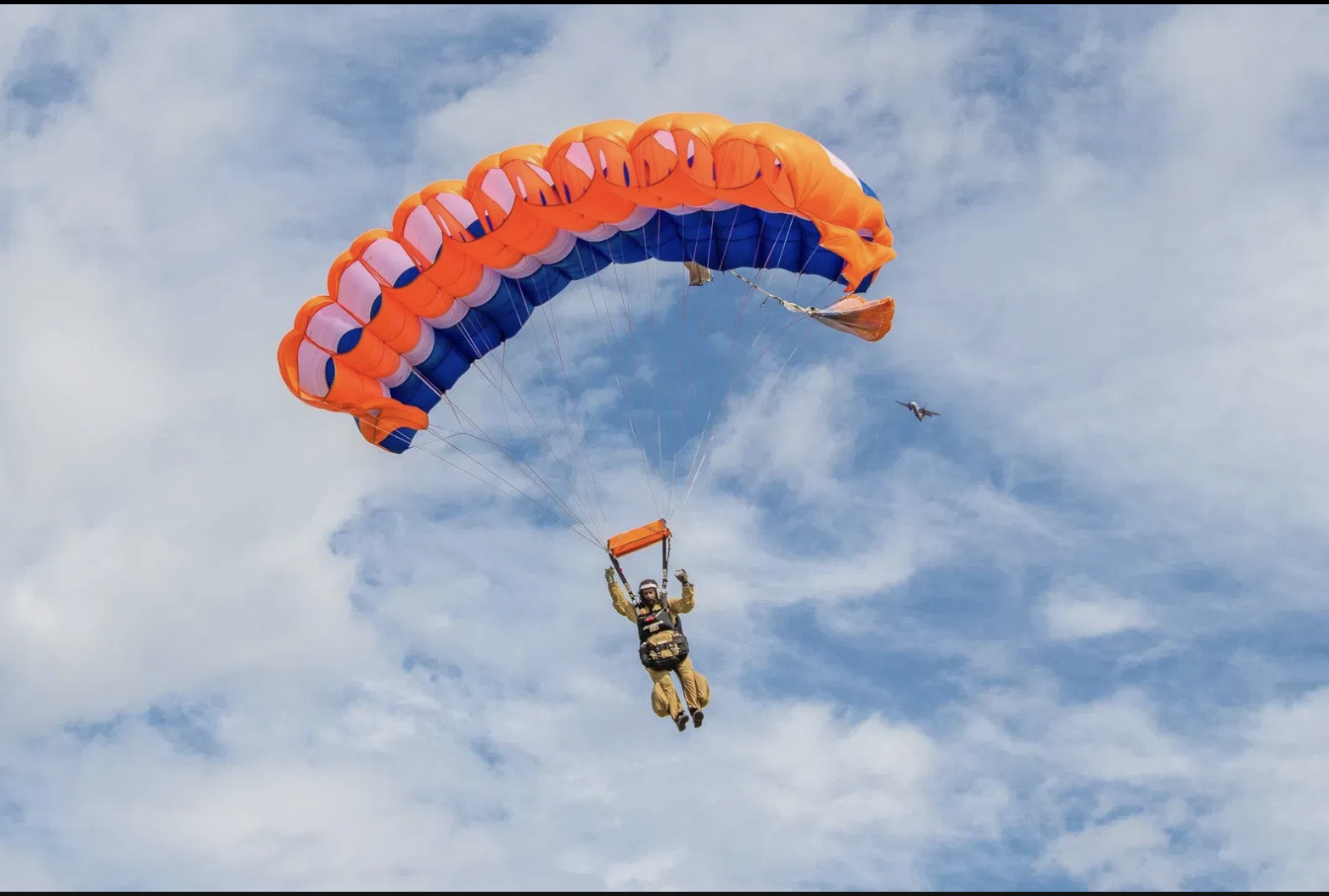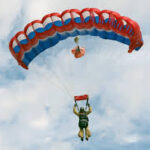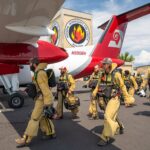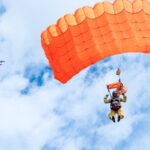
by STEVE BENHAM | KATU Staff
REDMOND, Ore. (KATU) — It’s not hard to compare the nation’s smokejumpers to elite U.S. special forces, like the Navy’s SEALs.
Smokejumpers are specialized wildland firefighters, but instead of being deployed to kill terrorists, they parachute into hard-to-reach wilderness areas to put out small wildfires before they become raging infernos. They are initial, fast-attack teams with the ability to quickly get to fires that could take ground crews days to reach.
But Joe Madden, a U.S. Forest Service smokejumper, downplays the perception that he’s part of an elite group of wildland firefighters.
“I don’t think you’ll find too many people here telling you that we’re an elite group. We’re just folks that are here that have kind of found their niche,” he says while standing in the Redmond Smokejumper Base in this high desert Central Oregon town of around 37,000 people.
But the fact is he’s part of a small group. There are fewer than 400 smokejumpers in the nation. Fifty of them are based in Redmond.
They can also be deployed to the middle of nowhere for up to two weeks, so self-sufficiency and survival skills are a must.
Madden has been a smokejumper for 10 years. Before that he worked with the Prineville Hotshot crew, and before that, he was on a hand crew out of Bend, just a 30-minute drive south of Redmond. This year is his 16th fire season. He exemplifies the training and experience a person needs to be a smokejumper. It’s not an entry-level position. You can’t be a smokejumper without first working as a wildland firefighter.

Smokejumper Joe Madden, suited up in his jumpsuit, reserve parachute and personal equipment bag (front) and main parachute (back) at the Redmond Smokejumper Base’s Ready Room, shows what handle he pulls to deploy his main parachute. (Corry Young/KATU)
The Redmond Smokejumper Base is one of seven Forest Service bases in the country. Two others are operated by the Bureau of Land Management. All nine of them are in the West.
When the alarm sounds at the base, smokejumpers are trained to don around 100 pounds of gear in two minutes before hopping onto a plane to be flown to a fire, which in its initial stages may only be an acre in size.
The History of Smokejumping
Parachuting into fires started in the United States in the early 1940s. The Forest Service began experimenting with the concept in 1939 at the North Cascades Smokejumper Base in Winthrop, Washington, and the next year firefighters parachuted into a fire in Idaho.
From there, smokejumper bases started popping up in the West, and in 1964, the one in Redmond was established. At that time, there were 23 jumpers, according to the Forest Service.

Various types of parachutes smokejumpers have used in the past hang from a wall in the rigging room of the Redmond Smokejumper Base. (Corry Young/KATU)
The history of the base is captured in photographs on the walls, including group pictures of crews posing in front of airplanes. There are also pictures from fires that crews have jumped in past years. Older parachutes and harnesses adorn a wall in the rigging room, where the smokejumpers pack their chutes into deployment bags and containers.
WATCH BELOW: History of Smokejumping presented by the National Smokejumper Association:
Josh Cantrell, the training manager at the base, says this year there were 106 applicants for rookie smokejumper positions in Region 6, which encompasses the Redmond and Winthrop bases. Ten were selected for training at the Redmond base and as of last month, eight were still in the running.
Cantrell says the attrition rate among candidates is about 40%.
The physical requirements to be a smokejumper are high. Candidates must be able to do seven pull-ups, 45 sit-ups and 25 pushups. Plus, they’re required to run 1.5 miles in less than 11 minutes.
But physical requirements are just one aspect of what makes a good smokejumper.
“It’s a broad recruitment pitch, but I could cook it down to hardworking, intelligent, motivated individual who’s looking to challenge themselves and work in the wildland, in a challenging environment,” Cantrell says.
What they don’t need is prior parachute experience. Almost no smokejumper coming into the program has jumped out of a plane.
“Sewing” Tradition
Ever since the beginning of the smokejumper program, rookies have learned how to sew. This is because smokejumpers make all their gear at the base except for the parachutes.

Smokejumpers make and repair their own gear here in the sewing room at the Redmond Smokejumper Base. (KATU)
An entire room at the Redmond base is dedicated to the task. Sewing machines of different sizes for different purposes line the walls. Large tables allow the smokejumpers to assemble backpacks, equipment bags, harnesses and their jumpsuits, made of Kevlar to help protect them from sharp tree limbs if they were to land in a tree.
“The equipment we use is mostly purpose built, that there isn’t a retailer or manufacturer out there that does create the stuff the way we’re using it,” Cantrell says. “This stuff gets damaged, and we need to be able to continue to use it. … If something does get damaged, we can fix it in a timeline to put it right back into service.”
“Get Ready!”
For liability reasons, the Forest Service doesn’t allow the media to go on fly-alongs on its planes. Nor does it allow the media to attach GoPros or other cameras to its planes or its smokejumpers, but it has posted numerous videos on the internet showing smokejumpers preparing for and executing jumps.
The airplane rides are noisy, and the wind whips at the open door from which the smokejumpers will exit.
There are crewmembers called spotters stationed near the rear of the plane. While tethered to the inside of the fuselage, they lean out the door to help determine a safe area in which to drop the smokejumpers as close as possible to the fire.
The smokejumpers attach one end of what is known as a static line to a cable stretched along the ceiling of the plane. The other end is hooked up to their parachute system strapped on their backs.
“Get ready!” the spotter shouts as the plane approaches the drop zone.
At that moment, a smokejumper grasps the sides of the exit door with both hands. A moment later, the spotter slaps the jumper on the shoulder and then he or she plunges into nothing but a 3,000-foot column of air.

“Getting a good exit, it’s like a really tricky thing,” says Madden. “It’s kind of like shoving yourself out into the middle of the river.”
The static line, still attached to the cable in the plane, pulls what is known as a drogue chute out of the jumper’s parachute system. Jumpers are trained to tighten into a “cannon ball.” The drogue chute and the jumper’s body position provide stability in the air.
While in freefall, the smokejumper counts, ticking off five seconds.
“Jump thousand. Look thousand. Reach thousand. Wait thousand. Pull thousand.”
With that, the jumper pulls on a large green handle on the left shoulder harness, and the main parachute, a 360-square-foot canopy, deploys, allowing the jumper to navigate slowly to the ground, which takes around two minutes.
After all the smokejumpers have landed in the jump spot, the airplane crew circles around, descends to 500 feet above the ground and prepares to deploy cargo, such as large cardboard boxes tethered to 16-foot round parachutes. Those boxes contain enough food and water for three days for two people and sleeping bags.
The boxes also contain tools, especially the all-important Pulaski, the primary hand tool of the wildland firefighter. Crews use the tool for chopping trees and digging lines around fires.
Other items are dropped to the fire as well, including chain saws and, if mechanized tools are forbidden in a part of the wilderness, crosscut saws, for manual cutting of trees.
Large parachutes are used to drop pallets of equipment and supplies.
Smokejumpers at the base in Redmond fly in Sherpa SD3-60s, twin-engine turboprop aircraft. The planes were once used by the military in wars such as in Afghanistan.
On these planes, the back end can open upward into the fuselage, allowing for easy deployment of cargo. Other planes used by smokejumpers may not have this feature and cargo is “kicked” out the same door the smokejumpers used.
What you drop in you must pack out and packing out at least 100 pounds of gear per person over miles of rough terrain is another reason smokejumpers must be in good physical condition. A typical pack-out to the nearest road for pick up is around five miles. Cantrell says the longest pack-out he’s been on was around 10.
“By the time you get to the road after carrying 110 pounds over any distance, you’re ready to put the thing down,” he says.
Also, knowing how to read a map in the wilderness is a plus.
“For us, the consequences of not knowing how to read a map or convey that information to somebody on the outside can mean the difference of a short pack-out or a very long pack-out,” Cantrell says. “This stuff is heavy, and it doesn’t pack itself.”

Making your own gear, packing parachutes, requirements to be in top physical shape, wilderness survival skills, work in unforgiving and dangerous terrain, long treks through the woods with heavy gear strapped to your back, and jumping out of airplanes from thousands of feet in the air, sounds like elite work.
Despite all that, Madden remains humble. He notes that smokejumpers, once on the ground, are wildland firefighters who perform the same work as others in the business of putting out wildfires.
Wildland firefighting at any level can require specialized skills and good mental and physical durability, but smokejumping does offer a person more opportunities to grow as a person.
“At least for the most part, it’s not really the adrenaline-seeking type of folks. It’s more the folks that are just trying to find a challenge,” Madden says about the people who want to become smokejumpers. “It’s a really great career for somebody that wants to make themselves better at something every year. … Generally, the people that come here thinking it’s gonna be this big adrenaline rush, there’s enough down time that that’s not necessarily the case.”
KATU’s Wright Gazaway contributed reporting.
SOURCE: https://ktxs.com/news/nation-world/redmond-oregon-smokejumpers-stand-ready-for-initial-attack-on-wildfires-history-smokejumping-aircraft-sherpa-sd360-spotters






